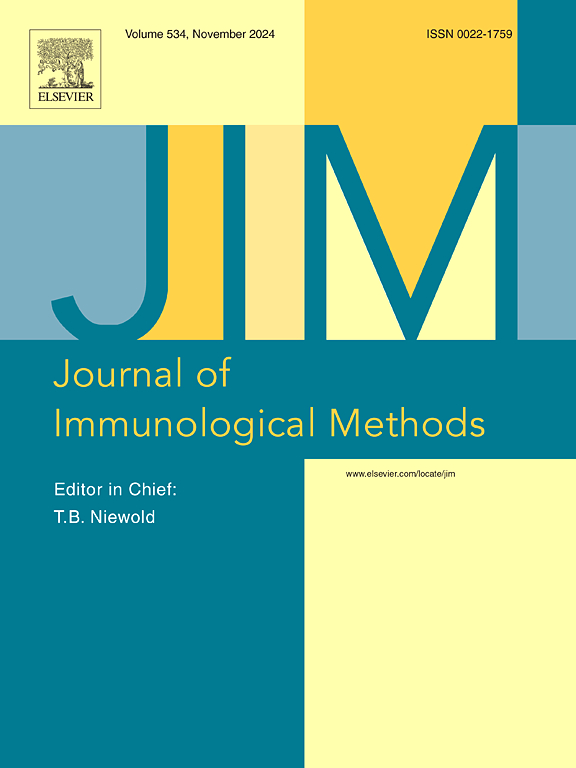Development of an enteric pathogen multiplex immunoassay to measure antibody responses in blood and saliva for integrated serology applications
IF 1.6
4区 医学
Q4 BIOCHEMICAL RESEARCH METHODS
引用次数: 0
Abstract
Background
Enteric infections are a leading cause of global morbidity and mortality, with the highest burden of disease in young children in low- and middle-income countries. Comprehensive profiling of enteric infections, which requires intensive sampling and molecular and culture-based detection methods, may miss recent and historical infections. High-throughput antibody-based testing of blood or non-invasive specimens like saliva can fill this gap, especially in vulnerable populations.
Methods
We developed a bead-based multiplex immunoassay (MIA) that includes enteric pathogen targets from bacteria (Shigella, Enterotoxigenic Escherichia coli [ETEC], Campylobacter, typhoidal Salmonella, non-typhoidal Salmonella); viruses (norovirus, rotavirus, hepatitis E virus, adenovirus, astrovirus); and protozoa (Cryptosporidium, Giardia), as well as select targets for respiratory viruses and vaccine preventable diseases (VPDs). Coupling was optimized for peptide and lipopolysaccharide (LPS) antigens separately and assay performance characterized for both serum and salivary applications.
Results
The ability to assess IgG and IgA antibody responses in serum ranging over 4 orders of magnitude was demonstrated, allowing for assessment of various phases of infection. The mean inter-operator assay precision was excellent (6.7 % CV in serum IgG and 10.6 % CV in saliva IgG). The MIA was highly correlated (r = 0.72–0.96, p < 0.0001) with reference ELISA antibody titers in selected antigens.
Conclusions
Improved scalability of enteric pathogen detection through an MIA may be combined with existing serosurveillance for VPDs and respiratory viruses and complement broad enteric pathogen burden and vaccine studies. This framework for integrated serology provides methods for assessing disease burden to inform prevention and treatment guidelines and guide targeted interventions.
开发一种肠道病原体多重免疫测定法,以测量血液和唾液中的抗体反应,用于综合血清学应用。
背景:肠道感染是全球发病率和死亡率的主要原因,低收入和中等收入国家幼儿的疾病负担最高。肠道感染的综合分析,需要密集的采样和分子和培养为基础的检测方法,可能会错过最近和历史感染。基于高通量抗体的血液或唾液等非侵入性标本检测可以填补这一空白,特别是在脆弱人群中。方法:我们开发了一种基于微球的多重免疫分析法(MIA),包括来自细菌的肠道病原体靶标(志贺氏菌、产肠毒素大肠杆菌、弯曲杆菌、伤寒沙门氏菌、非伤寒沙门氏菌);病毒(诺如病毒、轮状病毒、戊型肝炎病毒、腺病毒、星状病毒);和原生动物(隐孢子虫、贾第鞭毛虫),以及呼吸道病毒和疫苗可预防疾病(VPDs)的选定目标。分别优化了多肽和脂多糖(LPS)抗原的偶联,并对血清和唾液的检测性能进行了表征。结果:评估血清中IgG和IgA抗体反应的能力超过4个数量级,允许评估不同阶段的感染。操作者间测定的平均精密度非常好(血清IgG为6.7 % CV,唾液IgG为10.6 % CV)。结论:通过MIA可提高肠道病原体检测的可扩展性,可与现有的vpd和呼吸道病毒血清监测相结合,并补充广泛的肠道病原体负担和疫苗研究。这一综合血清学框架提供了评估疾病负担的方法,为预防和治疗指南提供信息,并指导有针对性的干预措施。
本文章由计算机程序翻译,如有差异,请以英文原文为准。
求助全文
约1分钟内获得全文
求助全文
来源期刊
CiteScore
4.10
自引率
0.00%
发文量
120
审稿时长
3 months
期刊介绍:
The Journal of Immunological Methods is devoted to covering techniques for: (1) Quantitating and detecting antibodies and/or antigens. (2) Purifying immunoglobulins, lymphokines and other molecules of the immune system. (3) Isolating antigens and other substances important in immunological processes. (4) Labelling antigens and antibodies. (5) Localizing antigens and/or antibodies in tissues and cells. (6) Detecting, and fractionating immunocompetent cells. (7) Assaying for cellular immunity. (8) Documenting cell-cell interactions. (9) Initiating immunity and unresponsiveness. (10) Transplanting tissues. (11) Studying items closely related to immunity such as complement, reticuloendothelial system and others. (12) Molecular techniques for studying immune cells and their receptors. (13) Imaging of the immune system. (14) Methods for production or their fragments in eukaryotic and prokaryotic cells.
In addition the journal will publish articles on novel methods for analysing the organization, structure and expression of genes for immunologically important molecules such as immunoglobulins, T cell receptors and accessory molecules involved in antigen recognition, processing and presentation. Submitted full length manuscripts should describe new methods of broad applicability to immunology and not simply the application of an established method to a particular substance - although papers describing such applications may be considered for publication as a short Technical Note. Review articles will also be published by the Journal of Immunological Methods. In general these manuscripts are by solicitation however anyone interested in submitting a review can contact the Reviews Editor and provide an outline of the proposed review.

 求助内容:
求助内容: 应助结果提醒方式:
应助结果提醒方式:


